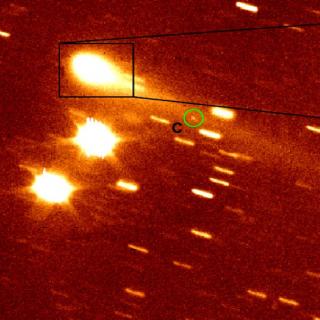General
La formación y evolución de galaxias masivas se entiende razonablemente bien en el contexto del exitoso formalismo estándar ΛCDM. Sin embargo, estas simulaciones de la evolución cósmica plantean serios retos en el régimen de las galaxias muy débiles, incluidos los problemas denominados satélites perdidos, demasiado grandes para fallar, y planos de galaxias satélites. Con la enorme cantidad de excelentes datos que se están produciendo gracias a los sondeos astronómicos, y con las nuevas misiones programadas para obtener más datos de una calidad aún mejor, existe una oportunidad única de resolver estos problemas. Para ello, es necesario un planteamiento innovador en el campo de las tecnologías de la información. En EDUCADO (Exploración del Universo Profundo mediante el Análisis Computacional de Datos de Observaciones), una estrecha colaboración en la que confluyen la astronomía y la informática, agruparemos a expertos de distintas disciplinas y sectores. Se formarán 10 estudiantes de doctorado en el desarrollo de una variedad de métodos de alta calidad, necesarios para abordar la formación de las estructuras más débiles. Se detectarán de forma fiable y reproducible un número sin precedentes de galaxias débiles observables a partir de nuevos sondeos de gran área. Se estudiará la morfología, las poblaciones y la distribución de grandes muestras de diversas clases de galaxias enanas y se compararán con poblaciones y propiedades de galaxias enanas en distintos entornos. Además, se contrastarán los resultados con modelos cosmológicos de formación y evolución de galaxias. Por último, se realizarán observaciones y simulaciones detalladas, sólidas y basadas en principios de la Vía Láctea y el Grupo Local para compararlas con galaxias enanas de otros entornos. EDUCADO ofrecerá un programa de formación interdisciplinar, intersectorial e internacional que incluirá una estancia en uno de los 11 socios asociados para cada estudiante de doctorado. De este modo, se ofrecerá una oportunidad novedosa y sostenible de formar a doctores con conocimientos interdisciplinares e intersectoriales en ciencia de datos, un elemento indispensable para la competitividad europea del futuro.
Miembros
Resultados
— Spina, L; Quandt R, M.; Magrini, L.; Berni, L.; Lucatello, S.; Canducci, M.
eprint arXiv:2509.18268.
— Sarkar, S.; and Petersen, M.
The Journal of Open Source Software 2025, 10 (109), 7009.
— Sánchez-Alarcón, P. M.; Salo, H.; Knapen, J. H.; et al.
Astronomy & Astrophysics 2025, 697, A38, 18 pp.
— Knapen, J. H.; Boffin, H. M.J; Chamba, Nushkia; Chamba, Natasha.
Nature Astronomy, 9, p. 951-956.
— Martocchia, S.; Boselli, A.; et al (including Junais).
Astronomy & Astrophysics 2025, 696, A79, 26pp.
— Kimming, L.C.; Brough, S.; et al (including Knapen, J. H.).
Astronomy & Astrophysics, 700, id.A95, 23 pp.
— Euclid Collaboration; Huertas-Company, M; et al (including Le, M. N.).
eprint arXiv:2503.15311.
— Esser, N.; Filion, C.; De Rijcke, S. et al.
Astronomy & Astrophysics 2025, 698, A290, 14pp
— Thuruthipilly, H,; Junais, et al.
Astronomy & Astrophysics 2025, 695, A106, 19pp.
— Bustos-Espinoza, R.; Blaña, M.; et al (including Junais).
eprint arXiv:2502.11041.
— Beard, M.; McHardy, I.M; et al (including Knapen, J. H.).
Monthly Notices of the Royal Astronomical Society 2025, 537, 1, 293pp.
— Sawant, P.; Nanni, A.; et al (including Junais).
Astronomy & Astrophysics 2025, 694, A82, 18pp.
— Lorenzon, G.; Donevski, D.; et al (including Junais).
Astronomy & Astrophysics 2025, 693, A118, 21pp.
— Saifollahi, A.; Lancon, A.; et al (including Le, M. N.).
Astronomy & Astrophysics 2025, 24pp.
— Larsen, S. S.; Ferguson, A. M. N.; et al (including Le, M. N.).
Astronomy & Astrophysics 2025.
— Golini, G.; Trujillo, I.; et al (including Le, M. N.).
Astronomy & Astrophysics 2025, 700, A91, 17pp.
— Euclid Collaboration: Urbano, M.; Duc, P. A., et al (including Le, M. N.).
arXiv:2509.13163.
— Euclid Collaboration: Siudek, M.; Huertas-Company, M.; et al (including Dunn, M.).
arXiv:2503.15312.
— Euclid Collaboration: Corcho-Caballero, P.; Ascasibar, Y.; et al (including Dunn, M.).
Astronomy & Astrophysics 2025.
20. CO-CAVITY project: Molecular gas and star formation in void galaxies
— Rodriguez, M.I.; Lisenfeld, U.; et al (including Peletier, R. F.).
Astronomy & Astrophysics 2024, 692, A125, 18pp.
21. First Detection of Molecular Gas in the Giant Low Surface Brightness Galaxy Malin 1
— Galaz, G.; González-López, J.; et al (including Junais).
The Astrophysical Journal Letters 2024, 975, L26, 9pp.
22. CAVITY: Calar Alto Void Integral-field Treasury surveY: I. First public data release
— García-Benito, R.; Jiménez, A.; et al (including Peletier, R. F.)
Astronomy & Astrophysics 2024, 691, A161, 17 pp.
Gas-phase metallicity for the Seyfert galaxy NGC 7130
— Amiri, A.; Knapen, J. H. et al.
Astronomy & Astrophysics 2024, 689, A193, 6pp.The IAC's in-kind contribution to Rubin LSST: 10.4m GTC observing time
— Knapen, J. H.
ZENODO 2024.The Complete Spitzer Survey of Stellar Structure in Galaxies (CS4G )
— Sánchez-Alarcón, P. M. et. al.
ZENODO 2024.Inferring stellar population properties with simulation-based inference in the LSST era.
— Iglesias-Navarro, P. et. al.
ZENODO 2024.



